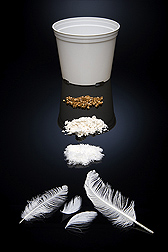Chicken Feathers and Glass: Our Heroes
 |
| Photo by Stephen Ausmus |
For years now, the human race has used
plastics for pretty much everything: plastic bags, wrapping paper/packaging
from online stores, bottles, and so on. But what if there were alternate
solutions to plastic, solutions that were bio-degradable and did not stay in
the environment past our lifetime? These options exist, and it is imperative
everyone starts to learn about these other options if we want to keep our environment
healthy.
While they may be considered antiquated by some, glass bottles were used for quite a while before plastic bottles were invented.
Glass is bio-degradable and does not consume fossil fuels, meaning that it
helps our environment in multiple ways. It is also made from sand, which is a natural
resource. Some companies have already switched to glass, whereas others have
gone in the opposite direction; this shows that the option for glass is possible
when it comes to bottles.
Another option that is still in the works is using chicken feathers. Now, this may seem a bit far-fetched, but chicken feathers have been found to be usable as a form of plastic. Except, this is the kind of plastic that is bio-degradable and also natural, which is called thermoplastic. This means that just like glass, it does not require the use of fossil fuels to be made. So far, the chicken feather thermoplastic has withstood heat tests, making it malleable for multiple purposes. And for those worried about possible bird diseases, the heat that is used during the process of making the thermoplastic destroys those pathogens.
Another option that is still in the works is using chicken feathers. Now, this may seem a bit far-fetched, but chicken feathers have been found to be usable as a form of plastic. Except, this is the kind of plastic that is bio-degradable and also natural, which is called thermoplastic. This means that just like glass, it does not require the use of fossil fuels to be made. So far, the chicken feather thermoplastic has withstood heat tests, making it malleable for multiple purposes. And for those worried about possible bird diseases, the heat that is used during the process of making the thermoplastic destroys those pathogens.
These are just two options in a world that is creating more in order to save our environment. So the next time you are looking at a cold beverage aisle, take a look at which companies care about long-sustaining ideas, and others who only have fossil fuel plastic; spread the word because chickens, not plastic companies, are the ones who are looking out for us.
Resources:

Comments
Post a Comment
Let your knowledge, ideas, and innovation be heard. Tell us what you think and know about this topic.